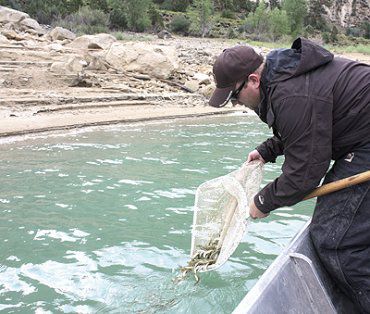The Division of Wildlife Resources planted 3,000 tiger muskies at Joe’s Valley Reservoir on Friday. The tiger muskies were three-four inches in length. Brandon Ivory from the Fountain Green fish hatchery brought the fish to Joe’s Valley where they were distributed around the shoreline of the lake by Calvin Black and Justin Hart from the Division of Wildlife Resources. The fish were hatched and raised in South Dakota and brought by truck to Utah.
Hart said they released some tiger muskies earlier this year in Joe’s Valley that were hatched at the LeeKay Center and then raised in Fountain Green. They want to raise more of their own tiger muskie in the future to help keep costs down. The fish put into Joe’s Valley this week cost $9 a fish.
In May of this year there was a gill net survey of the fish in Joe’s Valley Reservoir. There were several age classes of tiger muskie collected with the larger fish averaging 37 to 38 inches and up to 13-14 pounds. Hart said he has heard reports that there are now fish reaching the 40 inch slot limit, but he hasn’t seen any himself or any pictures of tiger muskie big enough to keep. When the fish do reach this size you can keep one over 40 inches.
Joe’s Valley has become a trophy splake fishery. The Utah chub still infest Joe’s Valley and other trout species have struggled to compete with the chub. The splake have been sustaining themselves and have been eating the chub.
The DWR worked for several years mechanically removing the chub, but they aren’t going to do that any more and are letting the larger fish hopefully take care of the chub problem.
The first tiger muskies were planted into Joe’s Valley in 2009, the first stocking was of 11 inch fish. The next stocking was smaller two inch fish. The funding for these fish came from a donation by Sportsmen for Fish and Wildlife, the Emery County Travel Bureau, and Food Ranch. It is a goal to have one adult fish per acre. Hart said they want to be conservative with stocking. The tiger muskie are expensive right around $2 per inch.
The tiger muskie will eat anything and they are eating the chubs as expected because one chub 9.5 inches was found inside one of the larger tiger muskies during the gill net survey. “We have to be careful not to overstock, we want to sustain a great fishery,” said Hart.
“We will continue to stock splake from five-eight inches. In the summer the splake really go deep and you don’t catch many, but we expect the tiger muskie will still be catchable during the summer months.
“The tiger muskies will help revitalize the fishery at Joe’s Valley and will help take those chub numbers down. “If we get those chubs down we can stock with rainbow again,” said Hart.
Hart said the chubs are so successful because they reproduce rapidly, can grow large, and they live a long time.
The tiger muskie is a sterile cross between the muskellunge and the northern pike. The tiger muskie has some of the characteristics of both of these fish. The pattern of the tiger muskie is varying amounts of color with vertical dark stripes on a light background. The pattern on a tiger muskie very rarely is the same as a northern pike. The body is deeper than the body of either parent fish, but that is common in hybrid fish. The caudal fins are more rounded than the tails of true muskies. The tiger muskie has 10 to 16 pores on the lower part of its jaw, unlike the northern pike.
Tiger muskie for Joe’s Valley

"Calvin Black speads the three-four inch tiger muskies along the shoreline at Joe's Valley Reservoir."
